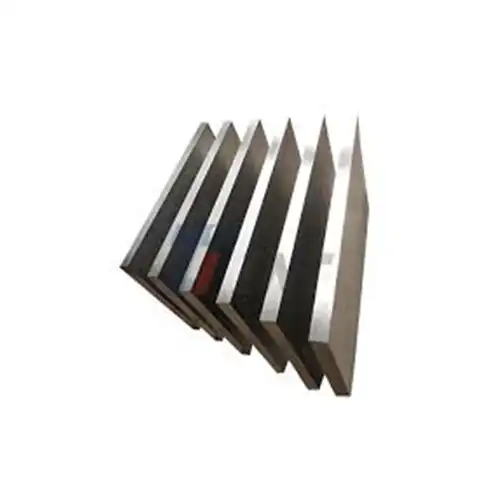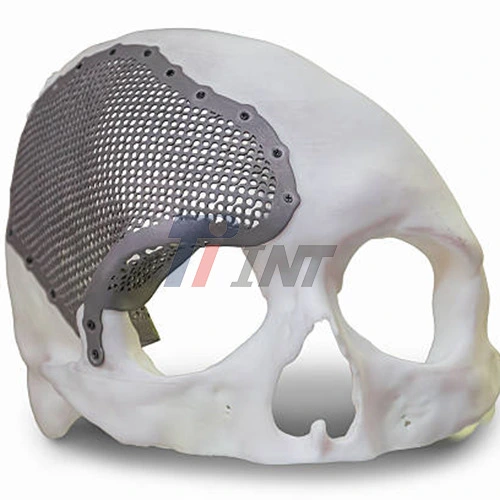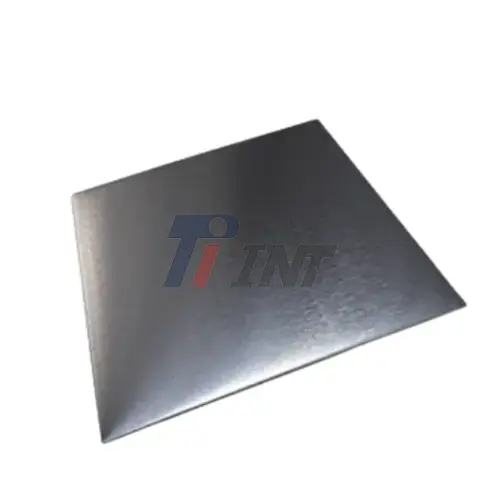How Titanium Plates Aid in Brain Surgery for Faster Healing?
 2025-08-26 10:08:27
View:389
2025-08-26 10:08:27
View:389Titanium plates play a crucial role in titanium plate brain surgery, significantly enhancing the healing process and patient outcomes. These innovative medical devices provide essential support and protection to the brain during and after surgical procedures. Made from high-grade titanium alloys, these plates offer exceptional biocompatibility, ensuring minimal risk of adverse reactions. Their lightweight yet durable nature allows for optimal performance without adding unnecessary pressure on delicate brain tissues. The corrosion-resistant properties of titanium plates guarantee long-term reliability, even in the challenging environment of the human body. With their high strength-to-weight ratio, these plates offer the flexibility needed for precise placement during intricate neurosurgical procedures, promoting faster healing and recovery for patients undergoing brain surgery.
|
|
|
The Revolutionary Impact of Titanium in Neurosurgery
Unparalleled Biocompatibility: A Game-Changer in Brain Surgery
The use of titanium plates in brain surgery has revolutionized the field of neurosurgery. The unparalleled biocompatibility of titanium makes it an ideal material for implants in the human body, especially in sensitive areas like the brain. This exceptional compatibility stems from titanium's ability to form a stable oxide layer on its surface, which prevents corrosion and minimizes the risk of rejection by the body's immune system.
When used in brain surgery, titanium plates demonstrate remarkable integration with surrounding tissues. This seamless integration is crucial for several reasons:
- Reduced Inflammation: The body's response to titanium is minimal, resulting in less inflammation and faster healing.
- Lower Risk of Infection: The biocompatible nature of titanium significantly reduces the risk of post-operative infections.
- Enhanced Osseointegration: Titanium promotes bone growth around the implant, ensuring long-term stability.
These factors collectively contribute to a smoother recovery process for patients undergoing brain surgery, allowing them to heal more quickly and with fewer complications.
Strength and Durability: Supporting Delicate Structures
The strength and durability of titanium plates are paramount in brain surgery applications. Despite being remarkably lightweight, these plates exhibit exceptional structural integrity, providing robust support to delicate brain tissues and structures. This unique combination of strength and lightness is particularly beneficial in neurosurgery for several reasons:
- Minimal Pressure: The lightweight nature of titanium plates ensures they don't exert undue pressure on brain tissues.
- Long-lasting Support: The durability of titanium means that the plates can provide long-term support without degradation.
- Resistance to Deformation: Even under stress, titanium plates maintain their shape, ensuring consistent protection.
These properties make titanium plates used in titanium plate brain surgery ideal for various neurosurgical procedures, from cranial reconstructions to complex brain tumor removals. The plates' ability to withstand the rigors of daily life while protecting sensitive neural structures is unmatched by other materials.
Customization and Precision: Tailoring Solutions for Each Patient
One of the most significant advantages of using titanium plates in brain surgery is the ability to customize them for each patient's unique needs. Advanced manufacturing techniques allow for precise shaping and sizing of titanium plates, ensuring a perfect fit for every individual. This customization is crucial in neurosurgery, where millimeter-level precision can make a substantial difference in patient outcomes.
The customization process typically involves:
- 3D Imaging: Utilizing CT or MRI scans to create detailed models of the patient's skull and brain.
- Computer-Aided Design (CAD): Using specialized software to design plates that perfectly match the patient's anatomy.
- Precision Manufacturing: Employing state-of-the-art techniques like CNC machining or 3D printing to create the customized plates.
This level of customization not only improves the fit and function of the titanium plates but also contributes to better aesthetic outcomes, which can be psychologically beneficial for patients recovering from brain surgery.
The Healing Process: How Titanium Plates Accelerate Recovery?
Minimizing Trauma: Gentle Support for Fragile Tissues
Titanium plates play a crucial role in minimizing trauma during and after brain surgery. Their unique properties allow them to provide essential support while causing minimal disturbance to the surrounding tissues. This gentle approach is vital in promoting faster healing and reducing the risk of complications.
Key aspects of how titanium plates minimize trauma include:
- Smooth Edges: Carefully designed to prevent irritation or damage to adjacent tissues.
- Even Distribution of Pressure: Helps prevent localized stress on brain structures.
- Flexibility: Allows for slight movement, mimicking natural skull mechanics.
By providing a stable environment with minimal disruption, titanium plates create optimal conditions for the brain to heal. This reduction in trauma translates to less pain, reduced swelling, and a quicker return to normal brain function for patients.
Promoting Bone Regeneration: A Scaffold for Healing
One of the most remarkable aspects of titanium plates used in titanium plate brain surgery is their ability to promote bone regeneration. This property is particularly beneficial in cases involving cranial reconstruction or repair. Titanium's unique surface characteristics create an ideal environment for osteoblasts (bone-forming cells) to adhere and proliferate.
The process of bone regeneration around titanium plates involves:
- Initial Attachment: Osteoblasts readily adhere to the titanium surface.
- Cell Proliferation: The conducive environment promotes the multiplication of bone cells.
- Matrix Formation: Osteoblasts begin to secrete bone matrix, gradually forming new bone tissue.
- Integration: Over time, the new bone tissue integrates with the titanium plate, creating a strong, stable structure.
This ability to facilitate bone growth not only aids in faster healing but also contributes to the long-term stability and integrity of the surgical site. As a result, patients experience improved structural support and a reduced likelihood of future complications.
Reducing Infection Risks: A Barrier Against Pathogens
Infection prevention is a critical aspect of post-operative care in brain surgery. Titanium plates excel in this area, offering significant advantages in reducing the risk of infections. The properties of titanium that contribute to this reduced infection risk include:
- Antimicrobial Surface: Titanium naturally resists bacterial adhesion and colonization.
- Inert Nature: The material does not react with bodily fluids or tissues, minimizing inflammation.
- Smooth Finish: The polished surface of titanium plates leaves little room for bacteria to hide and multiply.
These characteristics create an environment that is inhospitable to pathogens, significantly lowering the risk of post-operative infections. For patients, this means a reduced likelihood of complications, shorter hospital stays, and a smoother recovery process overall.
Advancements and Future Prospects in Titanium Plate Technology
Innovative Coatings: Enhancing Performance and Bioactivity
The field of titanium plate technology for brain surgery is continually evolving, with innovative coatings at the forefront of recent advancements. These coatings are designed to enhance the already impressive properties of titanium, offering even greater benefits for patients and surgeons alike.
Some of the cutting-edge coating technologies being explored include:
- Hydroxyapatite Coatings: Improve bone integration and accelerate healing.
- Antimicrobial Coatings: Provide an additional layer of protection against infections.
- Growth Factor Coatings: Stimulate tissue regeneration and enhance healing processes.
These advanced coatings not only improve the performance of titanium plates used in titanium plate brain surgery but also open up new possibilities for treating complex brain conditions. As research in this area continues, we can expect to see even more sophisticated coating technologies that further optimize the healing process and patient outcomes.
Nanotechnology Integration: Precision at the Microscopic Level
The integration of nanotechnology with titanium plates represents a groundbreaking development in neurosurgery. This fusion of technologies allows for unprecedented precision and control at the microscopic level, potentially revolutionizing how we approach brain surgery and post-operative care.
Key applications of nanotechnology in titanium plates include:
- Nanostructured Surfaces: Enhance cell adhesion and promote faster tissue integration.
- Drug Delivery Systems: Allow for localized, controlled release of medications directly at the surgical site.
- Biosensors: Enable real-time monitoring of healing progress and early detection of complications.
The potential of nanotechnology in this field is vast, offering the promise of more targeted treatments, reduced side effects, and improved patient monitoring. As these technologies mature, they are likely to become integral components of titanium plates used in brain surgery, further enhancing their efficacy and versatility.
Smart Materials: The Future of Adaptive Healing
The concept of smart materials represents the next frontier in titanium plate technology for brain surgery. These advanced materials have the potential to adapt and respond to changes in the body, providing dynamic support throughout the healing process.
Potential features of smart titanium plates include:
- Shape Memory: Plates that can change shape in response to temperature or other stimuli, allowing for post-operative adjustments without additional surgery.
- Self-Healing Properties: Materials that can repair minor damage or wear over time, extending the lifespan of the implant.
- Bioactive Surfaces: Plates that actively promote tissue regeneration and adapt to the changing needs of the healing process.
While many of these technologies are still in the research and development phase, they hold immense promise for the future of neurosurgery. Smart titanium plates could potentially offer more personalized, adaptive solutions for patients, further improving recovery times and long-term outcomes.
Conclusion
Titanium plates, including titanium plate brain surgery, have undeniably transformed the landscape of brain surgery, offering a combination of biocompatibility, strength, and customization that is unmatched by other materials. Their ability to promote faster healing while minimizing risks has made them an invaluable tool in neurosurgery. As we look to the future, the integration of advanced technologies like innovative coatings, nanotechnology, and smart materials promises to further enhance the capabilities of titanium plates, potentially revolutionizing brain surgery outcomes.
For those interested in learning more about cutting-edge medical titanium products, including titanium plates for brain surgery, Baoji INT Medical Titanium Co., Ltd. offers a wealth of expertise and high-quality solutions. With over 30 years of experience in the research, development, and production of titanium materials, INT is at the forefront of medical titanium innovation. To explore their range of products or discuss specific requirements, interested parties are encouraged to reach out via email at export@tiint.com.
References
1. Winkler, P. A., et al. (2000). Titanium cranioplasty and the prediction of complications. Neurosurgical Focus, 8(1), 1-6.
2. Khader, B. A., & Towler, M. R. (2016). Materials and techniques used in cranioplasty fixation: A review. Materials Science and Engineering: C, 66, 315-322.
3. Xu, Y., et al. (2015). Nanotechnology and nanomaterials for improving neural interfaces. Advanced Functional Materials, 25(29), 3456-3478.
4. Wang, X., et al. (2016). Biomimetic modification of porous TiNbZr alloy scaffold for bone tissue engineering. Tissue Engineering Part A, 22(11-12), 891-901.
5. Ratner, B. D., et al. (2013). Biomaterials science: an introduction to materials in medicine. Academic press.












